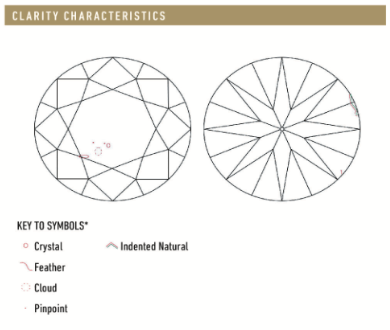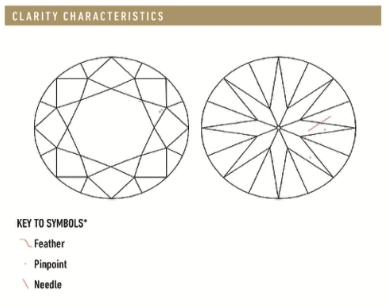When it comes to clarity we think the most important distinction is between diamonds with inclusions you can’t see and diamonds with inclusions you can. And that’s why VS2 clarity diamonds are the grade we recommend most often: they are the least expensive diamonds in the “inclusions you can’t see” pile. You can’t be sure that lower clarity grades won’t have eye-visible inclusions.
When grading a diamond’s clarity, graders examine the diamond under 10x magnification. They do this all day every day and they are really good at finding even the smallest little pinpoints and crystals in diamonds. You, on the other hand, will probably look at your diamond’s inclusions under magnification only once. How much do you really want to spend for the satisfaction of seeing almost nothing during those few seconds?
Sometimes consumers get an exaggerated idea of the importance of inclusions because they view diamond images at huge magnifications. When you are looking at an image of a 6.5mm one-carat diamond blown up to the size of a baseball, a pinpoint that you would never see at actual size becomes noticeable, even prominent.
Diamond clarity is based on the number, size, relief, nature, and position of inclusions. Generally VS2 diamonds will have many tiny inclusions or one or two larger inclusions.
The more inclusions there are in a diamond, the more they affect its overall appearance. But the size of inclusions is even more important because the bigger the inclusion, the more likely you are to see it. That’s especially true if an inclusion is a contrasting color. Black inclusions are much more noticeable than larger transparent or white inclusions.
The location of inclusions is one of the most important clarity factors. Diamonds with inclusions in the center of the table will receive a lower clarity grade because they are the easiest to see. Diamonds with inclusions near the pavilion can reflect like a hall of mirrors so you see a single inclusion more than once. In contrast, inclusions near the girdle can be hidden by prongs, making them difficult to see when the diamond is set.
Diamonds that are graded VS2 have minor inclusions that range from difficult to somewhat easy to see for a skilled grader using 10x magnification.
You will see a combination of features like feathers, naturals, pinpoints, clouds, needles and crystals. The range of inclusions in VS2 diamonds is wider than in higher clarity grades. That’s why it is important to evaluate the size and position of inclusions to find the best value. (ROSI, our diamond-picking AI powered by IBM’s Watson, automatically evaluates the inclusions of VS2 diamonds to find the best value for your money.)
In these two diamonds, the diamond on the left has a cluster of low relief features in the center. Much better is the diamond on the right that has almost no visible inclusions other than one large needle.
We never recommend buying a diamond that has chips, cavities, knots, etched channels, or manufacturers remnants because they affect a diamond’s beauty and durability too much. We also don’t recommend selecting a diamond that has a feather inclusion in the corner or point of a fancy shape. (ROSI automatically screens for these type of inclusions.)
You won’t see the inclusions in a VS2 diamond with your naked eye. And you definitely won’t see them when your VS2 diamond is set in an engagement ring.
Diamonds with a VS2 clarity grade offer you the best balance of beauty and affordability. We think they are the best diamond value. Buying a diamond that has a lower clarity grade but still no eye-visible inclusions will leave more money in your budget to buy a larger, more beautifully cut diamond.
WHAT ROSI RECOMMENDS
ROSI recommends VS2 clarity diamonds as the best balance between quality and value. You won't see the inclusions in a VS2 diamond with the naked eye. ROSI evaluates the size and position of the inclusions in VS2 quality diamonds to find the best value. In general, ROSI doesn’t think the tiny differences in appearance between the top grades of the GIA clarity grading scale are worth the investment. But ROSI often does recommend you upgrade to VS1 clarity for step cuts like emerald cuts and Asscher cuts that have broad facets that show inclusions more easily. You also may want to upgrade to VS1 clarity if your diamond is larger than two carats. Inclusions are judged proportional to diamond size so it’s easier to see the inclusions in larger diamonds. ROSI automatically takes these factors into account when searching for a diamond with the best possible combination of quality and value.
How does ROSI know diamonds so well? We trained her with dozens of professional diamond buyers. We asked them which diamonds among thousands they would buy for themselves or their daughters. ROSI calculated how they balanced more than 30 individual quality factors and applies those lessons to sift through all the grading reports of all the diamonds available on the market to pick the best combination of quality and value. With ROSI, you’ll find that brilliant needle in the haystack every time.











